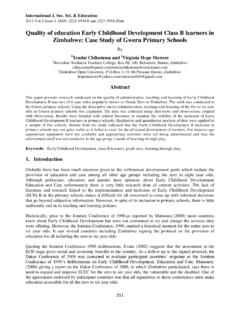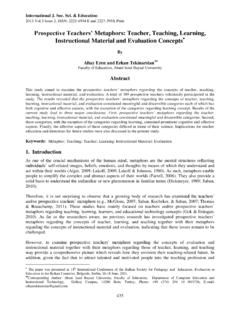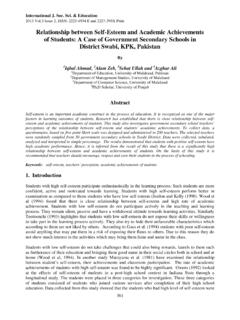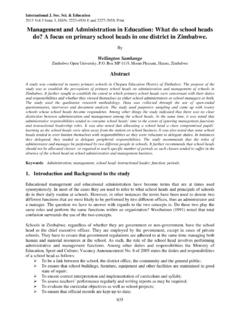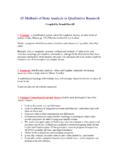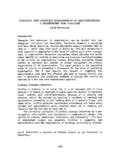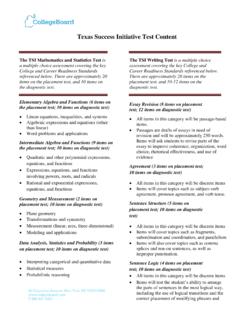Transcription of Language at War: A Critical Discourse Analysis of …
1 International J. Soc. Sci. & Education 2013 Issue 2, ISSN: 2223-4934 E and 2227-393X Print 378 Language at War: A Critical Discourse Analysis of speeches of Bush and Obama on Terrorism By Emmanuel Sarfo and Ewuresi Agyeiwaa Krampa Department of English, University of Cape Coast, Cape Coast, Ghana E-mail: & Abstract The concept of terrorism (and antiterrorism) is a complex phenomenon that has received a lot of debate in the last decade. A highly complex phenomenon, terrorism stands at the forefront of national and international agendas. Taking on many forms, it is associated with a wide variety of groups and motivations. It has been presented in different ways, depending on who is speaking. It is against this backdrop that this paper seeks to do a Critical Discourse Analysis (CDA) of speeches of Bush and Obama on terrorism.
2 Using six speeches from Bush and Obama as the data and using a qualitative content analytical approach, it draws on van Dijk s concept of Critical Discourse Analysis . The study reveals that Bush and Obama projected terrorism negatively while they projected anti-terrorism positively by carefully selecting emotionally charged vocabulary and expressions. The notion of power as control, mind control and context control were common features of Bush and Obama s speeches . This study has implications for the theory of Critical Discourse Analysis and studies on terrorism. Keywords: Terrorism, speech, linguistic forms, Critical Discourse Analysis , mind control. 1. Introduction A highly complex phenomenon, terrorism stands at the forefront of national and international agendas.
3 Taking on many forms, terrorism is associated with a wide variety of groups and motivations. Moreover, the emotionally charged nature of the term itself makes it especially difficult to define. In simple terms, terrorism is the threat or use of violence for political, religious or ideological purposes designed to influence the attitudes and behaviour of a group or to achieve objectives that are otherwise unattainable (Turner, Switzer & Redden, 1996; Rapport & Alexander, 1982). The Council of the European Union describes terrorism as an offence under national law, which, given its nature or context, may seriously damage a country or an international organization - seriously intimidating a population, or unduly compelling a Government or international organization to perform or abstain from performing any act, or seriously destabilizing or destroying the fundamental political, constitutional, economic or social structures of a country or an international organization (The Council of the European Union, 2002).
4 Although speeches on terrorism have been part of American politics for a long time now, they seem to have somewhat become more popular with ex-President Bush and the incumbent President, Barack Obama, since 2001, as a result of the 9/11 attacks on the World Trade Centre in New York. Seeing itself as probably the freest, decent and most powerful society in existence (D Souza, 2006), the US has a policy of no-negotiation-with-terrorists and therefore such speeches are usually used to criticize, warn, and invoke fear in the so-called terrorists. However, the issue of who a terrorist is has given rise to different interpretations and attitudes to/towards the term, with some justifying the legitimacy of terrorist acts if the cause is genuine.
5 [seeing] terrorism as a tool of resistance against outside influence and control (Turner, Switzer & Redden, 1996). For instance, in an interview with an ABC reporter, John Miller, in 1998, Osama bin Laden asserted that America has no the worst thieves in the world today and the worst terrorists are the Americans . In writing an introduction to Language , Discourse & Society, an international journal, O Hare (2011) quotes Professor Celine Marine Pascal as saying that Language is more than just a tool for communicating with another. To her, the world gains meaning Language at War: A Critical Discourse Analysis of speeches of Bush and Obama on Terrorism 379 through Language , and that one person s terrorist is another person s freedom fighter.
6 The Language we use both reflects and shapes the kind of world we create around us . This is a clear indication of the complexity of the term terrorism (or terrorist). It is therefore unsurprising that the concept of terrorism has attracted some scholarly attention. Agner (2002), whose article, Why terrorism doesn t work identifies some important reasons why terrorism conflicts tend to go into long-lasting deadlocks - the imbalance of power, the failure of negotiations and the effect of the mass media. Aning s (2010) War on terror examines the connections between development aid, security and the War on Terror (WOT) and finds that aid programmes have become highly securitized and politicized as a weapon for the realization of the goals of war on terror after 9/11.
7 Zysberg & Zysberg (2012) explore Differential reaction patterns to September 11th s events of Americans and bystander populations and conclude that Americans view the situation more as a war and tend to be less yielding or understanding toward the perpetrators than the bystander populations . In its study on Exploring the root and trigger causes of terrorism , the Transnational Terrorism, Security & the Rule of Law (2007), states that one of the causes of terrorism was that it was viewed as a means of communicating a message and using violence as a way to further solidify the triumph of their (terrorists) cause. Also, speeches have received considerable attention from scholars. Different approaches have been used in such studies, including: Critical Discourse Analysis (David & Dumanig, 2011; Horv th, 2011; Adetunji, 2006; Boyd, 2009); Critical Discourse Analysis with the Systemic Functional Linguistics (Kamalu & Agangan, 2011; Wang, 2010); Political Linguistics, Pu (2007); and checklist model (van Leeuwen, 2009).
8 These studies mostly highlighted issues of race, racism, identity, unity, cultural transmission and other political issues. Apart from that, while some of the studies were pragmatic, semantic or stylistic, others were lexico-grammatical in nature. Even though the current paper also employs CDA, it differs from those mentioned above as it focuses on the subject of terrorism. Again, what makes this study differ from other studies on terrorism is that it focuses on the linguistic portrayal of terrorism in the speeches of two American presidents. 2. The Present Study Theoretical Framework This paper draws on the Critical Discourse analytical theory. According to van Dijk (1998: 352), Critical Discourse Analysis (CDA) studies the way social power abuse, dominance and inequality are enacted, reproduced and resisted by text and talk in the social and political context.
9 He identifies some of the dominant notions in CDA as power , dominance , inequality , hegemony , ideology , class , gender , race , discrimination , among others which he labels as macro level of Analysis . However, he posits that micro-level of social order involves Language use, Discourse , verbal interaction and communication. CDA, thus, tries to bridge the 'gap' between the two micro and macro approaches. Fairclough (2003), on the other hand, classifies the various approaches of CDA into those that include a detailed Analysis of a text and approaches that do not involve a detailed text. According to Fairclough & Wodak (1997: 271-280) CDA addresses social problems. They posit that CDA regards: power relations as being discursive; Discourse as constituting society and culture; Discourse as doing ideological work; Discourse as history, making reference to culture, society and ideology in historical terms; that the link between text and society is mediated; that CDA is interpretative and explanatory; and Discourse as a form of social action.
10 Van Dijk asserts that CDA concentrates on the abuse of power especially on dominance, examining how power in Discourse is abused by controlling people s beliefs and actions to suit the interests of dominant groups as against the interest of the powerless or the will others. He says that those who have power Emmanuel Sarfo and Ewuresi Agyeiwaa Krampa 380 control Discourse . According to him, social power is the result of access to and control of resources such as force, money, status, fame, knowledge and information. In the exercise of these powers, dominant groups through text and talk, may either directly or indirectly coerce, influence, control or even abuse the minds of people through persuasion and manipulation. Text and talk control people s minds, and, therefore, Discourse may also indirectly influence people s actions through persuasion and manipulation.
